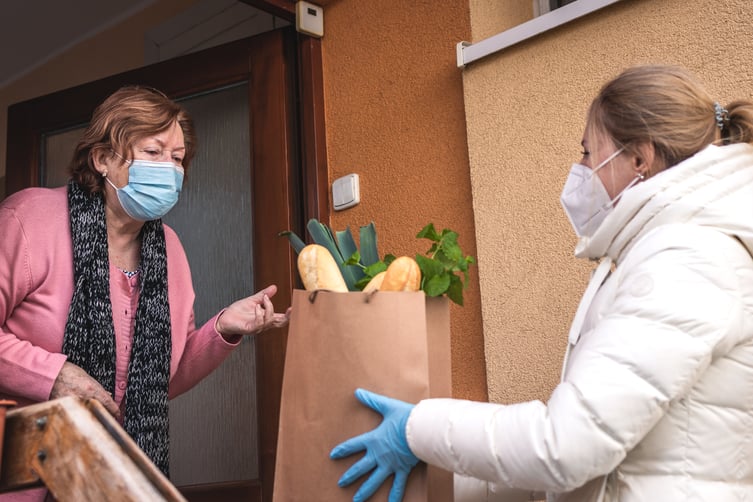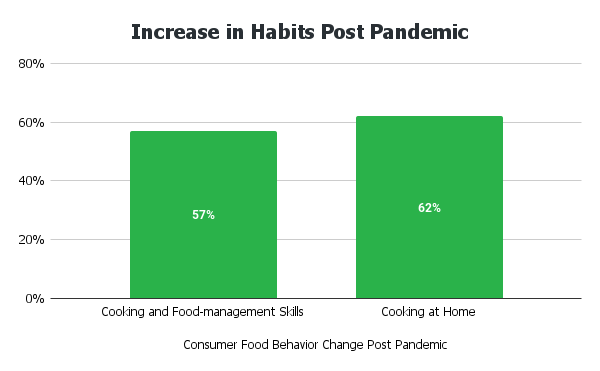
The Covid-19 pandemic has not only led to disruptions to our health systems but also affected our global economy, supply chain and transportation, our environment and food systems. Today, we’re going to explore how the pandemic influences our behavior around food and how Covid-19 plays a role in food waste.
Food waste has been a problem since the early 1900s due to industrialization and advancements in manufacturing products but has increased dramatically in the past few decades with the US wasting approximately 40% of our food supply today. When we waste food, we also waste all the resources that went into making that food, such as water, land, energy, and more.
Food Waste in the Supply Chain
Covid-19 has disrupted the entire food supply chain - for some sectors more than others. While many people experienced food shortages and saw empty shelves in grocery stores, there have been plenty of instances where there existed a surplus of food that couldn’t reach the consumer and therefore ended up being wasted. We can assume that food waste has increased dramatically in these instances while decreasing in others.
Foodservice
For example, all of the food meant for foodservice, such as restaurants, schools, and stadiums, now had nowhere to go, which meant that produce and other perishable food quickly went to waste. Grocery stores weren’t equipped to repurpose this food due to packaging limitations and product volumes, distribution challenges, and general supply chain restraints.
The beginning of the pandemic had the most dramatic impact on food waste. Continuing with our foodservice and restaurant example, many restaurants had to close during the first outbreak of Covid-19, which resulted in the waste of the food stock the restaurants already had. Even when restaurants started to re-open, it was difficult to determine demand due to consumer uncertainty, which also contributed to waste early on.
Producers and Manufacturers
When we look at the producer sector of the food supply chain, a lot of farms have been impacted, especially those that specialized in production for foodservice industries, due to lack of demand. Additionally, many farmers couldn’t just “pause” their production because of crop seasonality and the fact livestock can’t just stop producing or growing.
If we look at a specific crop, such as onions, and see that 40% are produced for restaurants, it’s not difficult to determine that the closures of foodservice industries played a large role in waste.
In terms of animals and livestock, through June 2020, the first few months of the pandemic, 3.7 million gallons of milk were dumped daily, 107,000 eggs were destroyed daily, and over 10 million hogs were euthanized due to Covid-19.
Covid-19 outbreaks in food processing and meatpacking plants, where many people work in close quarters, led to worker shortages and reduced plant capacities, which exacerbated how much food went to waste.
retailers
Additionally, at the beginning of the pandemic, retailers were uncertain about how to demand plan in response to changing consumer patterns. We’ve all noticed the empty shelves throughout the pandemic, but there was also a lot of surplus ordered that eventually went to waste. Consider high-end, quality products such as expensive meat and seafood that many people no longer wanted to purchase during the economic uncertainty of the pandemic.

While the general supply chain, inclusive of farmers, manufacturers, retailers, and restaurants, may have contributed to more food waste, at least at the onset of the pandemic, we believe that there may have actually been a decrease in food waste at the home and consumer level.
Shifting Consumer Behaviors
Our relationship with food is constantly changing due to a variety of factors, whether we’re trying a new diet we came across on social media, a new grocery store is opening up in our neighborhood, or we’re traveling and start experiencing new foods in different cultures. However, our relationship with food has never been so drastically altered as it has since the start of Covid-19.
Before the pandemic, a lot of Americans were constantly in a rush - commuting to and from work, driving their children to school and soccer practice, and attending social activities. This meant that for many people, there wasn’t a lot of time to be mindful when it came to food. Eating on the go, quick-service restaurants, and even vending machines made it easy to eat quickly for fuel while multitasking.
When the world seemingly screeched to a halt in March of 2020, there was suddenly a lot more time to consider what we’re eating, how we’re buying it, how we’re preparing or consuming it, how we store it, and what we do with any leftovers.
One reason that the pandemic caused such a substantial shift in our behaviors and relationship with food was simply the scale. The difference between the pandemic and another more specific event, such as starting a new diet, is that the pandemic is occurring to everyone - it’s a global event where everyone is affected so it has a more significant impact on consumer behavior overall.

As people spend more time at home and with their families without the countless distractions of the outside world, many turned to cooking and baking to pass the time or to start a new hobby. In fact, food became a comfort for many. 62% of a Science Direct survey respondents reported an increase in cooking at home in 2020 versus the year before, and 57% reported an increase in cooking and food-management skills. With more time dedicated to food without distractions, people became more mindful of the food in front of them.
Purchasing decisions
Arguably one of the biggest shifts in our behavior is how we purchase food. With restaurants and bars closing at the beginning of the pandemic, everyone turned to grocery stores to provide for themselves and their families. The panic that came with the unknown of the outbreak and uncertainty of having access to certain foods again led to mass shortages as everyone rushed to the grocery store to stock up on essentials.
“People didn’t realize that most of our food is typically packaged to supply to restaurants and hospitals, not necessarily for our homes. Our food system just wasn’t ready for such a dramatic shift in purchasing behavior,” said Brandon McFadden, assistant professor at the University of Delaware’s Department of Applied Economics and Statistics.
In addition to going to the grocery store less frequently to stock up and avoid spreading the virus, many people also turned to grocery delivery and pickup as an alternative to eating at restaurants. In fact, Americans are spending more than double on online groceries now, spending an average of $6.7 billion each month versus $3.1 billion before the pandemic. Even with inflation, Americans are continuing to rely on e-commerce, as it’s predicted e-commerce will account for 20% of the grocery market by 2026.
financial stresses
The pandemic also meant financial instability for many families, with the unemployment rate in America being the highest in April 2020 since the Great Depression. Food and groceries typically make up 7-27% of the average household’s budget, dependent on income. This means that for many, being mindful of saving all the food you have can be critical.
The pandemic also had a substantial impact on food access, with nearly ⅓ of Americans now facing food access challenges since the start of Covid-19.
So, not only are people, in general, more mindful of the food they’re consuming, but also of the financial impact that can occur when food is wasted. Since some people relied solely on restaurants for food, this could present a new challenge when it comes to finding the time to make food at home, but also an opportunity to save money by doing so.
storage solutions
As people started to visit grocery stores less frequently and stock up when they went, they had to make sure that the food they were purchasing could last until the next time they absolutely needed to make another trip So, storage became more of a priority. Learning how to properly store food, such as freezing what you won’t eat in time and learning what produce should be kept in the fridge versus the countertop, can increase your foods’ shelf life and ultimately save you money and from contributing to food waste.
In fact, due to the pandemic, 26% of US households added a refrigerator and 12% added a freezer by July of 2020. Optimizing food storage, especially cold storage options such as refrigerators and freezers, helps to add resilience to our food systems. For those that relied on prepared food at restaurants before the pandemic, the odds of having more frozen food at home even increased after the pandemic.
Food waste behavior
Before the pandemic, a lot of food waste came from eating on the go or at a restaurant. Think of all the food wasted because you’re in the car and can’t refrigerate leftovers, the food left on plates at restaurants, or even leftovers that you bring home, only to discard later.
A survey conducted by Science Direct found that the importance of food discard decisions (odor, how it looks, date labels, amount paid, storage limitations, etc) stayed relatively the same before and after the pandemic, with people listing physical signs such as “odor” and “looks safe to consume” as the 2 most important factors, with date labels following.
Although date labels aren’t the most looked at factor when making the decision to discard food, 80% of the survey participants still place importance on the date label. This has a negative impact on food waste as confusing date labels contribute to 90% of Americans throwing out perfectly good food, according to a ReFED report.
Because of the consumer behavior changes that we discussed earlier, such as being more mindful, less frequent trips to the grocery store, less waste at restaurants, increased storage capabilities, and financial considerations, there is a good reason to believe that food waste decreased at the home level.
The Food Industry Association’s survey stated that 36% of U.S. grocery shoppers felt they have been better at avoiding food waste since the pandemic and 51% believe they will continue to improve at it in the future. Another survey conducted by Food Insight in May of 2020 also resulted in 25% of respondents paying more attention to food waste created at home.
The results of the latest IPCC report are pretty grim and indicate that food systems contribute to about ⅓ of greenhouse gas emissions, so every effort in improving efficiency in our food system is critical to saving our planet.
One thing we’ve learned from the pandemic is how fragile our current food system is as it has disrupted the entire food supply chain. It’s important that we don’t “return back to normal” after the pandemic, but instead learn from what’s happened to create a brighter and healthier future.
So while it’s difficult to determine with absolute certainty whether food waste as a whole has increased or decreased due to the pandemic, the learnings and shift in consumer behavior can lead to a decrease in food waste, especially if we continue to slow down and be mindful of our relationship with food.
.png?width=250&name=SpoilerAlert_WhiteLogo_LeftStacked%20(7).png)